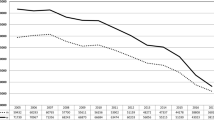Abstract
Purpose
Tonsillectomy is one of the most common surgical procedures in otorhinolaryngology. Hemorrhage in the postoperative period has an incidence of up to 20% and is a potentially fatal complication. We aim to assess the incidence of hemorrhage after tonsillectomy in our institution, and to evaluate and identify the possible associated risk factors.
Methods
This retrospective study included 897 patients who underwent tonsillectomy between January 2015 and December 2018, 50.7% women and 49.3% men, aged between 2 and 83 years. No coagulopathies were identified. Comparison of age, gender, surgical indication, coagulation profile, concomitant adenoidectomy, surgical technique, surgeon’s experience and hemostasis method between groups with and without post-operative bleeding was made.
Results
Our incidence of post-tonsillectomy hemorrhage was 6%. Most patients (83.3%) had secondary bleeding (> 24 h after surgery). In 22.2% of the bleeding cases, it was necessary to revise the hemostasis in the operating room. Adulthood (age ≥ 18 years) (p < 0.001), INR values ≥ 1.2 (p = 0.014), aPTT values ≥ 35 s (p = 0.001), as well as concomitant adenoidectomy (p < 0.001) were the predictors of post-tonsillectomy bleeding.
Conclusion
Recognition of adult age, INR ≥ 1.2, aPTT ≥ 35 s and concomitant adenoidectomy as risk factors can be useful in identifying the patients at higher risk for bleeding complications.
Similar content being viewed by others
References
Akin RC, Holst R, Schousboe LP (2012) Risk factors for post-tonsillectomy haemorrhage. Acta Otolaryngol 132:773–777
Betancourt AR, López C, Zerpan V, Carrasco M, Dalmau J (2015) Does surgical technique influence post-tonsillectomy haemorrhage? Acta Otorrinolaringol Esp 66(4):218–223
Heidemann CH et al (2009) Post-tonsillectomy hemorrhage: assessment of risk factors with special attention to introduction of coblation technique. Eur Arch Otorhinolaryngol 266:1011–1015
Ikoma R et al (2014) Risk factors for post-tonsillectomy hemorrhage. Auris Nasus Larynx 41:376–379
Negm H (2016) Factors affecting secondary post-tonsillectomy hemorrhage: a case–control study. Egypt J Otolaryngol 33:50–55
Tami TA, Parker GS, Taylor RE (1987) Post-tonsillectomy bleeding: an evaluation of risk factors. Laryngoscope 97:1307–1311
Curtin JM (1987) The history of tonsil and adenoid surgery. Otolaryngol Clin North Am 20:415–419
Mitchell RB et al (2019) Clinical practice guideline: tonsillectomy in children (update). Otolaryngol Head Neck Surg 160(1):S1–S42
Aljabr IK, Hassan FM, Alyahya KA (2016) Post-tonsillectomy hemorrhage after bipolar diathermy vs. cold dissection surgical techniques in Alahsa region. J Med 52:169–172
Bhattacharyya N, Kepnes LJ (2014) Revisits and postoperative hemorrhage after adult tonsillectomy. Laryngoscope 24:1554–1556
Blakley BW (2009) Post-tonsillectomy bleeding: how much is too much? Otolaryngol Head Neck Surg 140(3):228–290
Brett L, Sacks R (2007) Post-tonsillectomy bleeding. Otolaryngol Head Neck Surg 136:56–58
Brown P, Ryan R, Yung M et al (2005) National prospective tonsillectomy audit-final report. Royal College of Surgeons of England. 1–40. https://www.rcseng.ac.uk/-/media/files/rcs/library-and-publications/non-journal-publications/national-prospective-tonsillectomy-audit-finalreport-2005.pdf
Diercks GR et al (2019) Comparison of ibuprofen vs. acetaminophen and severe bleeding risk after pediatric tonsillectomy. JAMA Otolaryngol Head Neck Surg. 12:E1–E7
Gallagher T, Wilcox L, McGuiere E, Derkay C (2010) Analyzing factors associated with major complications after adenotonsillectomy in 4776 patients: comparing three tonsillectomy techniques. Otolaryngol Head Neck Surg 142:886–892
Krishna P, Lee D (2011) Post-tonsillectomy bleeding: a meta-analysis. Laryngoscope 111:1358–1361
Myssiorek D, Alvi A (1996) Post-tonsillectomy hemorrhage: an assessment of risk factors. Int J Pediatr Otorhinolaryngol 37:35–43
Walker P, Gillies D (2007) Post-tonsillectomy hemorrhage rates: are they technique-dependent? Otolaryngol Head Neck Surg 136:27–31
Windfuhr J (2013) Serious complications following tonsillectomy: are frequent are they really? ORL J Otorhinolaryngol Relat Spec 75:166–173
Baugh RF et al (2010) Clinical practice guideline: tonsillectomy in children. Otolaryngol Head Neck Surg 144(1):S1–30
Liu JH et al (2001) Post tonsillectomy haemorrhage. What is it and what should be recorded. Arch Otolaryngol Head Neck Surg 127:1271–1275
Wei JL, Beatty CW, Gustafson O (2000) Evaluation of posttonsillectomy hemorrhage and risk factors. Otolaryngol Head Neck Surg. 2:229–235
Windfuhr JP, Chen YS, Remmert S (2005) Hemorrhage following tonsillectomy and adenoidectomy in 15,218 patients. Otolaryngol Head Neck Surg 132:281–286
Spektor Z, Saint-Victor S, Kay DJ, Mandell DL (2016) Risk factors for pediatric post-tonsillectomy hemorrhage. Int J Pediatr Otorhinolaryngol 84:151–155
Susaman N, Kaygusuz I, Karlidag T, Keles E, Yalcin S, Cilibas RE (2018) Risk factors for post-tonsillectomy hemorrhage. ENT Updates 8(2):114–119
Gambôa I, Costa N, Duarte D, Oliveira N (2017) Morbilidade pós-amigdalectomia em idade pediátrica: comparação das técnicas de disseção a frio e com bipolar. Otorrinolaringology 55(1):9–13
Tomkinson A, Harrison W, Owens D, Harris S, McClure V, Temple M (2011) Risk factors for postoperative hemorrhage following tonsillectomy. Laryngoscope 121:279–288
Mueller J et al (2015) Population-based analysis of tonsil surgery and postoperative hemorrhage. Eur Arch Otorhinolaryngol 272:3769–3777
Schrock A et al (2009) The role of histology and other risk factors for post-tonsillectomy haemorrhage. Eur Arch Otorhinolaryngol 266:1983–1987
Duval M, Wilkes J, Korgenski K, Srivastava R, Meier J (2015) Causes, costs, and risk factors for unplanned return visits after adenotonsillectomy in children. Int J Pediatr Otorhinolaryngol 79:1640–1646
Zagólski O (2010) Post-tonsillectomy haemorrhage—do coagulation tests and coagulopathy history have predictive value? Acta Otorrinolaringol Esp 61(4):287–292
Sarny S, Ossimitz G, Habermann W, Stammberger H (2013) Preoperative coagulation screening prior to tonsillectomy in adults: current practice and recommendations. Eur Arch Otorhinolaryngol 270(3):1099–1104
Funding
This work did not receive any contribution, funding or scholarship.
Author information
Authors and Affiliations
Corresponding author
Ethics declarations
Conflict of interest
The authors declare that they have no conflict of interest.
Ethics approval
The authors declare that the procedures followed are in accordance with the regulations established by the directors of the Commission for Clinical and Ethical Research and in accordance with the Helsinki Declaration of the World Medical Association.
Additional information
Publisher's Note
Springer Nature remains neutral with regard to jurisdictional claims in published maps and institutional affiliations.
Rights and permissions
About this article
Cite this article
Gonçalves, A.I., Rato, C., de Vilhena, D. et al. Evaluation of post-tonsillectomy hemorrhage and assessment of risk factors. Eur Arch Otorhinolaryngol 277, 3095–3102 (2020). https://doi.org/10.1007/s00405-020-06060-1
Received:
Accepted:
Published:
Issue Date:
DOI: https://doi.org/10.1007/s00405-020-06060-1



